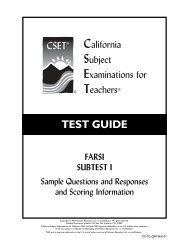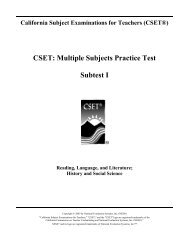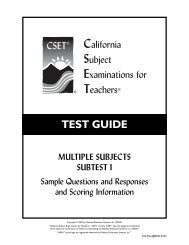TEST GUIDE ENGLISH SUBTEST I - CSETs
TEST GUIDE ENGLISH SUBTEST I - CSETs
TEST GUIDE ENGLISH SUBTEST I - CSETs
You also want an ePaper? Increase the reach of your titles
YUMPU automatically turns print PDFs into web optimized ePapers that Google loves.
English Subtest I<br />
30. Correct Response: C. (SMR Code: 1.3) Psychoanalytic criticism is based on the idea that literary<br />
works can reflect the imagined fulfillment of the author's thoughts and desires that are denied in real,<br />
everyday life or are prohibited by social or cultural standards—i.e., thoughts and desires that are censored<br />
by the self, or repressed. In this excerpt, the narrator is "filled with thoughts," most of which go unspoken<br />
or are repressed. However, she is still sometimes able to imagine these thoughts playing out freely—they<br />
"came pirouetting and stepping delicately, spread their tails, pecked their way. . . ."<br />
31. Correct Response: B. (SMR Code: 1.3) In reader-response criticism, the focus is on the individual<br />
activity or experience of reading a literary text and not on the author or the text itself. Literary meaning<br />
and value are created by the interaction of the reader and the text; hence, there is no one "correct"<br />
interpretation of a text. So, one way to take a reader-response approach to interpreting this excerpt from<br />
Emma would be to describe the experience of feeling sympathy for Emma because she is portrayed by the<br />
narrator as being stubborn and full of self-doubt, two very common human weaknesses.<br />
32. Correct Response: A. (SMR Code: 1.3) Formalist criticism focuses on the way individual literary<br />
elements combine to create a coherent whole text, independent of outside factors such as the author's life<br />
or intent, or the sociocultural and historical context. Formalist critics, for example, might examine how<br />
structure or syntax contributes to the theme or overall emotional impact of a text.<br />
33. Correct Response: B. (SMR Code: 1.4) Locating specific words or phrases in a traditional printed text<br />
can be extremely time consuming, even with a good index. If the text is available on the Internet, this task<br />
is greatly simplified, as the researcher can easily use an Internet search engine to locate the word or phrase<br />
in the text.<br />
34. Correct Response: C. (SMR Code: 1.4) The purpose of this excerpt from a public service document is<br />
to describe clearly and concisely the basic types of doctors that one might choose for one's physician. The<br />
bullets call attention to important details that clarify and elaborate on the four types of doctors identified<br />
in a topic sentence: general practitioner, family practitioner, internist, and geriatrician. The bulleted<br />
format helps readers locate each type quickly and distinguish between them easily.<br />
35. Correct Response: B. (SMR Code: 1.4) Although this workplace document does make reference to<br />
employees' rights, the primary purpose is provide explicit plans or methods of action for employees to<br />
take if/when they encounter unsafe conditions on the job. For each hypothetical situation, the employee is<br />
given a clear, appropriate, and expedient procedure or course of action to follow.<br />
36. Correct Response: D. (SMR Code: 1.4) This article indicates that, during the middle 1800s in New<br />
York City, free time, "leisure" time, or time for "recreation" was a luxury afforded mainly to the<br />
"fashionable classes," not the "great mass of our laboring classes." Working-class people had little means<br />
and few, if any, opportunities to escape the city, or even their homes, and visit a "place of attractive<br />
resort." But with the construction of Central Park, "a new state of things" emerged. Now, there was a<br />
public place where all citizens could go to enjoy "fresh air, recreation, and a pleasant walk or ride for<br />
themselves and their families." For working-class people, especially, spending Sunday in the park could<br />
be physically invigorating and spiritually uplifting.<br />
37. Correct Response: B. (SMR Code: 1.4) Patrick Henry's main purpose in this passage is to expose the<br />
actual designs of the British as opposed to their stated intentions. Henry suggests that actions, not words,<br />
are the best indicators of intent. Therefore he asks his listeners to look critically at the British's "insidious<br />
smile" and "gracious reception," which mask the hostile intent evident in their warlike conduct.<br />
42 California Subject Examinations for Teachers Test Guide








